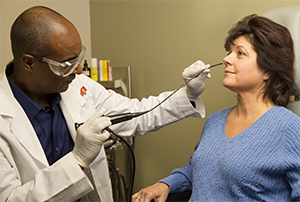A
B
C
D
E
F
G
H
I
J
K
L
M
N
O
P
Q
R
S
T
U
V
W
X
Y
Z
Topic IndexLibrary Index
Click a letter to see a list of conditions beginning with that letter.
Click 'Topic Index' to return to the index for the current topic.
Click 'Library Index' to return to the listing of all topics.
Evaluating Your Sinuses: History and Exam
The sinuses are hollow areas formed by the bones of the face. They help keep the nasal passages moist and free of dust and germs. If you have a sinus problem, you may need an evaluation. This helps a healthcare provider find out what's causing the problem. It's most often done by an ear, nose, and throat healthcare provider (ENT or otolaryngologist).
Health history
You'll be asked about your health history. Explain your symptoms. Tell your healthcare provider how long you've had the symptoms and what treatments you've used. Tell your provider what makes the symptoms get better and what makes them get worse. Mention other health problems you have. Mention if you take medicines. These include prescriptions and over-the-counter medicines, vitamins, herbs, or other supplements. You may be asked about signs of common problems of the sinuses. These can include:
-
Signs of a sinus infection. These can include long-term (chronic) yellow or greenish drainage, decreased sense of smell, facial pain or pressure, runny nose, and headache.
-
Signs of nasal allergies. These can include runny nose, sneezing, and red or itchy eyes or nose.
-
Signs of nasal blockage (obstruction). This can include needing to breathe through your mouth or nose on one side only.
Physical exam

During the exam, the healthcare provider looks into your ears and throat. Your nose will be checked for problems. These can include a deviated septum, polyps, or infection. You may also have an endoscopic exam. The provider uses a thin, lighted tube (endoscope) to see inside your nose and the sinuses. They'll first put a numbing medicine and a decongestant in your nose and sinuses. The provider will then put the endoscope into your nose. If problems are found, the provider will work with you to plan treatment.
Online Medical Reviewer:
Chris Southard RN
Online Medical Reviewer:
Marianne Fraser MSN RN
Online Medical Reviewer:
Ronald Karlin MD
Date Last Reviewed:
3/1/2024
© 2000-2025 The StayWell Company, LLC. All rights reserved. This information is not intended as a substitute for professional medical care. Always follow your healthcare professional's instructions.